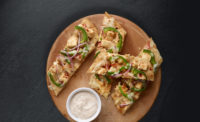Q&A with Christine Farkas, IHeartFood Consulting
A chef's perspective on beans, pulses and plant-based proteins




Prepared Foods talks with Christine Farkas, a chef consultant and founder of IHeartFood Consulting, a food product and culinary consulting firm in Vancouver, B.C. Farkas has a background in food product development, culinary management, and holistic nutrition.
Prepared Foods: We celebrated “the International Year of Pulses” in 2016 and shifted right into a plant-based foods movement. Why?
Christine Farkas: Chefs, foodservice operators, and manufacturers are targeting plant-forward menu and product options for consumers as interests and demands increase. Pulses are an exciting way to enhance the texture, appearance, and nutrition of a dish—all while avoiding major allergens. Meanwhile, beans, dry peas, lentils and chickpeas also are comparatively cost effective, which always is a great thing, especially in the food industry.
While whole and split pulses seem to be used more in foodservice, there are increasing options and opportunities with flours, fractions (fiber, protein, starches), flakes, purees and more. This all makes it more of a playground for chefs and food developers. Yet, I still think there’s a need for greater awareness.
PF: Beans and pulses also fit the growing interest for new ethnic foods, right?
Farkas: Dry peas, beans, lentils, and chickpeas play well in this area because they have historical significance that cultures globally consumed for years—and to present day. There’s a traditional significance, as well as a functional one when it comes to pairing pulses with global flavors; they act like chameleons and take on the flavors of co-ingredients, both delicate and robust (depending on the pulse used). They co-exist, highlight and take on flavors of vegetables, meat, and spices.
PF: What new bean- or pulse-based products have caught your eye in the market?
Farkas: I’m seeing the arena for plant-based milk using pulses expanding—both in the United States and Canada. Food companies are doing some amazing work developing nutrient-rich and neutral tasting products, which is exciting to see, especially because I’m an avid plant-based “milk” drinker.
Meanwhile, I certainly see growing SKUs for pulse pastas and crackers, chips and dips, granola bars, protein shakes, side dishes and meat analogues. The use of aquafaba in egg-less mayonnaise (Fabanaise) also is exciting to see and experience!
PF: Is there a particular new bean or pulse product you’ve worked on recently?
Farkas: I’ve had the opportunity to collaborate with foodservice chefs and food companies looking to explore pulses in existing and new food product applications. On that note, the USA Dry Pea & Lentil Council and Pulse Canada are excellent resources for application, health/nutrition, sustainability (and beyond) information.
On a personal side, I’ve teamed up with my husband to launch a craft hummus and dip company called “Thriving Craft,” located in Vancouver, B.C. Our line utilizes a range of pulses and our focus is on small batch production, creating inventive, flavor-packed products inspired by our global travels. The launch will be early 2018—so stay tuned!
Readers may contact Farkas at www.ihfc.ca, or connect via email at christine@ihfc.ca
Originally appeared in the January, 2018 issue of Prepared Foods as First Person.
Looking for a reprint of this article?
From high-res PDFs to custom plaques, order your copy today!







